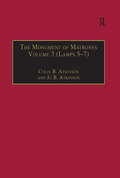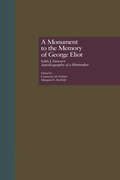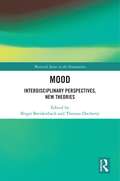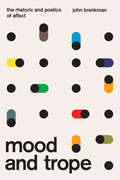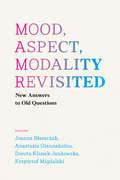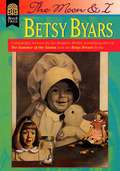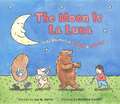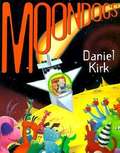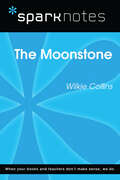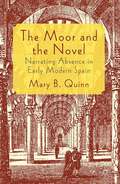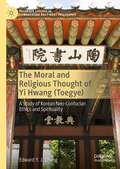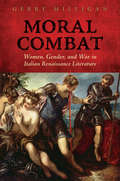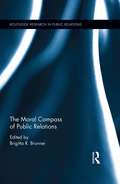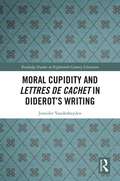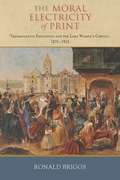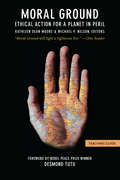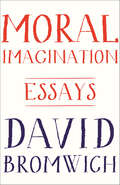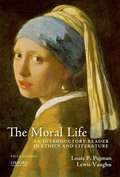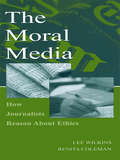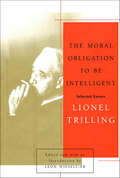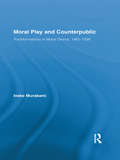- Table View
- List View
The Monument of Matrones Volume 3: Essential Works for the Study of Early Modern Women, Series III, Part One, Volume 6 (The Early Modern Englishwoman: A Facsimile Library of Essential Works for the Study of Early Modern Women Series III, Part One)
by Colin B. AtkinsonAs its compiler Thomas Bentley writes, The Monument of Matrones (1582) is a 'domesticall librarie plentifullie stored and replenished'. This 1500-page book is one of a long line of books of secular prayer reaching from the Middle Ages through the sixteenth-century English compilations of prayer and meditations that grew out of the English Reformation. It is unique because it is addressed specifically to women and contains prayers and meditations written by women as well as for them. The Monument helped define women's roles in the Anglican Church and is intertwined with the whole nature of the Protestant Reformation and the place of women in it. The work is divided into seven numbered parts which Bentley titles 'Lamps'. This structural theme is based on a fusion of the imagery of the wise and foolish virgins and their lamps in Matthew 25:1-13 with the vision of the seven lampstands (or seven-branched candlestick) in Rev.1:20-2:1. In this facsimile edition Volume 1 contains Lamps 1-3, Volume 2 contains Lamp 4, and Volume 3 contains Lamps 5-7. The Introductory Note that appears in each of the three volumes provides an overview of the contents of The Monument which will help the reader to appreciate the riches of this immense book. It is also significant in identifying, for the first time, the compiler Thomas Bentley as the churchwarden of St Andrew Holborn, City of London. The copy reproduced in this edition is the British Library copy; where necessary, pages from The Huntington Library copy have been substituted.
A Monument to the Memory of George Eliot: Edith J. Simcox's Autobiography of a Shirtmaker (Literature and Society in Victorian Britain #Vol. 4)
by Constance M. Fulmer Margaret E. BarfieldFirst published in 1998. Routledge is an imprint of Taylor & Francis, an informa company.
Monuments and Literary Posterity in Early Modern Drama
by Brian ChalkIn spite of the ephemeral nature of performed drama, playwrights such as Marlowe, Jonson, Webster, Fletcher, and Shakespeare were deeply interested in the endurance of their theatrical work and in their own literary immortality. This book re-evaluates the relationship between these early modern dramatists and literary posterity by considering their work within the context of post-Reformation memorialization. Providing fresh analyses of plays by major dramatists, Brian Chalk considers how they depicted monuments and other funeral properties on stage in order to exploit and criticize the rich ambiguities of commemorative rituals. The book also discusses the print history of the plays featured. The subject will attract scholars and upper-level students of Renaissance drama, memory studies, early modern theatre, and print history.
Mood: Interdisciplinary Perspectives, New Theories (Warwick Series in the Humanities)
by Birgit Breidenbach Thomas DochertyMood is a phenomenon whose study is inherently interdisciplinary. While it has remained resistant to theorisation, it nonetheless has a substantial influence on art, politics and society. Since its practical omnipresence in every-day life renders it one of the most significant aspects of affect studies, it has garnered an increasing amount of critical attention in a number of disciplines across the humanities, sciences and social sciences in the past two decades. Mood: Aesthetics, Psychology, Philosophy provides a comprehensive theoretical and empirical exploration of the phenomenon of mood from an interdisciplinary angle. Building on cutting-edge research in this emerging field and bringing together established and new voices, it bridges the existing disciplinary gap in the study of mood and further consolidates this phenomenon as a crucial concept in disciplinary and interdisciplinary study. By combining perspectives and concepts from the literary studies, philosophy, musicology, the social sciences, artistic practice and psychology, the volume does the complexity and richness of mood-related phenomena justice and benefits from the latent connections and synergies in different disciplinary approaches to the study of mood.
Mood and Trope: The Rhetoric and Poetics of Affect
by John Brenkman“Reconnect[s] affect studies with major issues in literary studies, philosophy, and aesthetics. . . . a fundamental contribution to this emergent field.” —Jonathan Culler, Cornell University, author of Structuralist PoeticsIn Mood and Trope, John Brenkman introduces two provocative propositions to affect theory: that human emotion is intimately connected to persuasion and figurative language; and that literature, especially poetry, lends precision to studying affect because it resides there not in speaking about feelings, but in the way of speaking itself.Engaging modern philosophers—Kant, Nietzsche, Heidegger, and Deleuze—Brenkman explores how they all approach the question of affect primarily through literature and art. He draws on the differences and dialogues among them, arguing that the vocation of criticism is incapable of systematicity and instead must be attuned to the singularity and plurality of literary and artistic creations. In addition, he confronts these four philosophers and their essential concepts with a wide array of authors and artists, including Pinter and Poe, Baudelaire, Jorie Graham and Li-Young Lee, Shakespeare, Tino Sehgal, and Francis Bacon. Filled with surprising insights, Mood and Trope provides a rich archive for rethinking the nature of affect and its aesthetic and rhetorical stakes.“Combining philosophical inquiry with brilliant interpretive readings, Brenkman, draws out the distinctive imbrications of mood and trope across a range of modern poetic projects.” —Amanda Anderson, Brown University, author of Psyche and Ethos“Brenkman shows us how literature has extended and deepened the possibilities of feeling and knowledge of feeling alike.” —Susan Stewart, Princeton University, author of The Open Studio: Essays on Art and Aesthetics“Eminently readable.” —Choice
Mood, Aspect, Modality Revisited: New Answers to Old Questions
by Joanna Błaszczak, Anastasia Giannakidou, Dorota Klimek-Jankowska, Krzysztof MigdalskiOver the past several decades, linguistic theorizing of tense, aspect, and mood (TAM), along with a strongly growing body of crosslinguistic studies, has revealed complexity in the data that challenges traditional distinctions and treatments of these categories. Mood, Aspect, Modality Revisited argues that it’s time to revisit our conventional assumptions and reconsider our foundational questions: What exactly is a linguistic category? What kinds of categories do labels such as “subjunctive,” “imperative,” “future,” and “modality” truly refer to? In short, how categorical are categories? Current literature assumes a straightforward link between grammatical category and semantic function, and descriptions of well-studied languages have cultivated a sense of predictability in patterns over time. As the editors and contributors of Mood, Aspect, Modality Revisited prove, however, this predictability and stability vanish in the study of lesser-known patterns and languages. The ten provocative essays gathered here present fascinating cutting-edge research demonstrating that the traditional grammatical distinctions are ultimately fluid—and perhaps even illusory. Developing groundbreaking and highly original theories, the contributors in this volume seek to unravel more general, fundamental principles of TAM that can help us better understand the nature of linguistic representations.
The Moon and I
by Betsy ByarsWhile describing her humorous adventures with a blacksnake, Betsy Byars recounts childhood anecdotes and explains how she writes a book.
The Moon Is La Luna
by Jay M. HarrisThis book is full of monos, ratons, and osos. What’s that, you say? You don’t know what a mono is? What about a rio, some pelo, or even an árbol? No? Still no idea? You should read this libro, then. By the time you finish, you’ll be able to recognize and understand more than fifty simple Spanish words. You’ll be saying, "Mas, por favor!” You may even ask your papá to buy you a gato or pato. (But not your papa. Potatoes can’t buy pets. )
Moondogs
by Daniel KirkThere are amazing-looking dogs on the moon! Young Willy knows because he has been watching them through his telescope. When his dad suggests he ought to have a pet, Willy builds a rocket just his size, and sets off on the adventure of a lifetime. Willy's heart is set on finding a dog like you've never seen before and readers will be surprised to see what he brings home!
The Moonstone (SparkNotes Literature Guide Series)
by SparkNotesThe Moonstone (SparkNotes Literature Guide) by Wilkie Collins Making the reading experience fun! Created by Harvard students for students everywhere, SparkNotes is a new breed of study guide: smarter, better, faster. Geared to what today's students need to know, SparkNotes provides: *Chapter-by-chapter analysis *Explanations of key themes, motifs, and symbols *A review quiz and essay topicsLively and accessible, these guides are perfect for late-night studying and writing papers
The Moor and the Novel
by Mary B. QuinnThis book reveals fundamental connections between nationalist violence, religious identity, and the origins of the novel in the early modern period. Through fresh interpretations of music, literature, and history it argues that the expulsion of the Muslim population created a historic and artistic aperture that was addressed in new literary forms.
The Moral and Religious Thought of Yi Hwang: A Study of Korean Neo-Confucian Ethics and Spirituality (Palgrave Studies in Comparative East-West Philosophy)
by Edward Y. ChungThis book presents Yi Hwang (1501–1570)—better known by his pen name, Toegye—Korea’s most eminent Confucian philosopher. It is a pioneering study of Toegye’s moral and religious thought that discusses his holistic ideas and experiences as a scholar, thinker, and spiritual practitioner. This study includes Toegye’s major texts, essays, letters, and biographies. Edward Chung explains key concepts, original quotations, annotated notes, and thought-provoking comments to bring this monumental thinker and his work to life. Chung also considers comparative and interreligious perspectives and their contemporary relevance. By offering groundbreaking insights into Neo-Confucianism, this book sheds fresh light on the breadth and depth of Toegye’s ethics and spirituality, and is an important source for scholars and students in Korean and Confucian studies and comparative philosophy and religion.
Moral Authority, Men of Science, and the Victorian Novel
by Anne DewittNineteenth-century men of science aligned scientific practice with moral excellence as part of an endeavor to secure cultural authority for their discipline. Anne DeWitt examines how novelists from Elizabeth Gaskell to H. G. Wells responded to this alignment. Revising the widespread assumption that Victorian science and literature were part of one culture, she argues that the professionalization of science prompted novelists to deny that science offered widely accessible moral benefits. Instead, they represented the narrow aspirations of the professional as morally detrimental while they asserted that moral concerns were the novel's own domain of professional expertise. This book draws on works of natural theology, popular lectures, and debates from the pages of periodicals to delineate changes in the status of science and to show how both familiar and neglected works of Victorian fiction sought to redefine the relationship between science and the novel.
Moral Combat: Women, Gender, and War in Italian Renaissance Literature (Toronto Italian Studies)
by Gerry MilliganThe Italian sixteenth century offers the first sustained discussion of women’s militarism since antiquity. Across a variety of genres, male and female writers raised questions about women’s right and ability to fight in combat. Treatise literature engaged scientific, religious, and cultural discourses about women’s virtues, while epic poetry and biographical literature famously featured examples of women as soldiers, commanders, observers, and victims of war. Moral Combat asks how and why women’s militarism became one of the central discourses of this age. Gerry Milligan discusses the armed heroines of biography and epic within the context of contemporary debates over women’s combat abilities and men’s martial obligations. Women are frequently described as fighting because men have failed their masculine duty. A woman’s prowess at arms was asserted to be a cultural symptom of men’s shortcomings. Moral Combat ultimately argues that the popularity of the warrior woman in sixteenth-century Italian literature was due to her dual function of shame and praise: calling men to action and signaling potential victory to a disempowered people.
The Moral Compass of Public Relations (Routledge Research in Public Relations)
by Brigitta R. BrunnerThe civic and moral responsibilities of public relations are hotly contested topics. While many researchers call for focusing on ethics in public relations, they concentrate on ethics in relation to how people do their jobs. In actuality, emphasis should move beyond professional codes of ethics to include general morality and citizenship. Currently, as the profession receives greater scrutiny, it is important to be aware of the value of public relations in the community. This book centers on four areas of public relations’ conscience in order to examine its role in morality and citizenship: civic professionalism, corporate social responsibility, ethics, and public communication. This approach will help to answer the question of what is public relations’ responsibility to the public good.
Moral Cupidity and Lettres de cachet in Diderot’s Writing (Routledge Studies in Eighteenth-Century Literature)
by Jennifer VanderheydenThis volume explores the influence of the lettre de cachet on both Diderot’s personal life and his works, beginning with an examination of Diderot’s experience as recipient of two such arrest warrants, followed by an analysis of his references to these warrants in three of his fictional works, Le Père de famille, Jacques le fataliste and Est-il bon? Est-il méchant?. A scrutiny of Diderot’s mémoire/lettre novel La Religieuse proposes that, on the basis of moral cupidity, or self-gain, Madame Simonin sends her daughter Suzanne two veiled lettres de cachet that demand her confinement to a convent. The exploration of a fascinating real-life case of Henriette-Émilie de Bautru, a young comtesse whose mother confined her to a convent as a result of a lettre de cachet also based on motives of greed, leads to an examination of the similarities between Suzanne and the Comtesse in terms of their illegitimacy, questioning of authority and subsequent rebellion. A consideration of writing and communication in La Religieuse as they relate to this rebellion leads to an investigation of Diderot’s admiration of the mystery of female genius and artistic creativity as discussed in his essay Sur les femmes. The works of Julia Kristeva, especially her Post-Scriptum addressed to Diderot at the end of her work Thérèse mon amour: Thérèse d’Avila, serve as a theoretical basis for an interpretation of Suzanne’s experience as victim of a lettre de cachet and her search for a psychological rebirth of her être caché.
The Moral Electricity of Print: Transatlantic Education and the Lima Women's Circuit, 1876-1910
by Ronald BriggsMoral electricity—a term coined by American transcendentalists in the 1850s to describe the force of nature that was literacy and education in shaping a greater society. This concept wasn't strictly an American idea, of course, and Ronald Briggs introduces us to one of the greatest examples of this power: the literary scene in Lima, Peru, in the nineteenth century.As Briggs notes in the introduction to The Moral Electricity of Print, "the ideological glue that holds the American hemisphere together is a hope for the New World as a grand educational project combined with an anxiety about the baleful influence of a politically and morally decadent Old World that dominated literary output through its powerful publishing interests." The very nature of living as a writer and participating in the literary salons of Lima was, by definition, a revolutionary act that gave voice to the formerly colonized and now liberated people. In the actions of this literary community, as men and women worked toward the same educational goals, we see the birth of a truly independent Latin American literature.
The Moral Electricity of Print: Transatlantic Education and the Lima Women's Circuit, 1876-1910
by Ronald BriggsBest Nineteenth-Century Book Award Winner, 2018, Latin American Studies Association Nineteenth-Century Section Moral electricity—a term coined by American transcendentalists in the 1850s to describe the force of nature that was literacy and education in shaping a greater society. This concept wasn't strictly an American idea, of course, and Ronald Briggs introduces us to one of the greatest examples of this power: the literary scene in Lima, Peru, in the nineteenth century. As Briggs notes in the introduction to The Moral Electricity of Print, "the ideological glue that holds the American hemisphere together is a hope for the New World as a grand educational project combined with an anxiety about the baleful influence of a politically and morally decadent Old World that dominated literary output through its powerful publishing interests." The very nature of living as a writer and participating in the literary salons of Lima was, by definition, a revolutionary act that gave voice to the formerly colonized and now liberated people. In the actions of this literary community, as men and women worked toward the same educational goals, we see the birth of a truly independent Latin American literature.
Moral Ground: Teaching Guide
by Kathleen Dean Moore Michael P. NelsonA Teaching and Study Guide for Moral Ground: Ethical Action for a Planet in Peril
Moral Imagination: Essays
by David BromwichCompelling essays from one of today's most esteemed cultural criticsSpanning many historical and literary contexts, Moral Imagination brings together a dozen recent essays by one of America's premier cultural critics. David Bromwich explores the importance of imagination and sympathy to suggest how these faculties may illuminate the motives of human action and the reality of justice. These wide-ranging essays address thinkers and topics from Gandhi and Martin Luther King on nonviolent resistance, to the dangers of identity politics, to the psychology of the heroes of classic American literature.Bromwich demonstrates that moral imagination allows us to judge the right and wrong of actions apart from any benefit to ourselves, and he argues that this ability is an innate individual strength, rather than a socially conditioned habit. Political topics addressed here include Edmund Burke and Richard Price's efforts to define patriotism in the first year of the French Revolution, Abraham Lincoln’s principled work of persuasion against slavery in the 1850s, the erosion of privacy in America under the influence of social media, and the use of euphemism to shade and anesthetize reactions to the global war on terror. Throughout, Bromwich considers the relationship between language and power, and the insights language may offer into the corruptions of power.Moral Imagination captures the singular voice of one of the most forceful thinkers working in America today.
The Moral Life: An Introductory Reader in Ethics and Literature (Fifth Edition)
by Louis P. Pojman Lewis VaughnIdeal for introductory ethics courses, The Moral Life: An Introductory Reader in Ethics and Literature, Fifth Edition, brings together an extensive and varied collection of ninety-one classical and contemporary readings on ethical theory and practice. Integrating literature with philosophy inan innovative way, this unique anthology uses literary works to enliven and make concrete the ethical theory or applied issues addressed. It also emphasizes the personal dimension of ethics, which is often ignored or minimized in ethics anthologies. The readings are enhanced by chapterintroductions, study questions, suggestions for further reading, and biographical sketches. The fifth edition adds ten new readings, eight of which appear in two new chapters: Feminist Ethics and the Ethics of Care and Global Economic Justice. An updated Companion Website at www. oup. com/us/pojman provides self-quizzes, essay questions, and helpful links for students and reading summaries,a test bank, and PowerPoint-based lecture slides for instructors.
The Moral Media: How Journalists Reason About Ethics (Routledge Communication Series)
by Lee Wilkins Renita ColemanThe Moral Media provides readers with preliminary answers to questions about ethical thinking in a professional environment. Representing one of the first publications of journalists' and advertising practitioners' response to the Defining Issues Test (DIT), this book compares thinking about ethics by these two groups with the thinking of other professionals.This text is divided into three parts:*Part I includes chapters that explain the DIT and place it within the larger history of three fields: psychology, philosophy, and mass communication. It also provides both a statistical (quantitative) and narrative (qualitative) analysis of journalists' responses to the DIT.*Part II adds to scholarship theory building in these three disciplines and makes changes in the DIT that adds an element of visual information processing to the test.*Part III explores the larger meaning of this effort overall and links the results to theory and practice in these three fields. The Moral Media pursues connections among various intellectual disciplines, between the academy and the profession of journalism, and among those who believe that what journalists do is essential. As a result, this book is appropriate for aspiring journalists; scholars in journalism and mass communication; psychologists, particularly those interested in human development and behavior; and philosophers.
The Moral Obligation to Be Intelligent: Selected Essays
by Lionel TrillingA landmark reissue of a great teacher's finest workLionel Trilling was, during his lifetime, generally acknowledged to be one of the finest essayists in the English language, the heir of Hazlitt and the peer of Orwell. Since his death in 1974, his work has been discussed and hotly debated, yet today, when writers and critics claim to be "for" or "against" his interpretations, they can hardly be well acquainted with them, for his work has been largely out of print for years.With this re-publication of Trilling's finest essays, Leon Wieseltier offers readers of many new generations a rich overview of Trilling's achievement. The essays collected here include justly celebrated masterpieces--on Mansfield Park and on "Why We Read Jane Austen"; on Twain, Dos Passos, Hemingway, Isaac Babel; on Keats, Wordsworth, Eliot, Frost; on "Art and Neurosis"; and the famous Preface to Trilling's book The Liberal Imagination.This exhilarating work has much to teach readers who may have been encouraged to adopt simpler systems of meaning, or were taught to exchange the ideals of reason and individuality for those of enthusiasm and the false romance of group identity. Trilling's remarkable essays show a critic who was philosophically motivated and textually responsible, alive to history but not in thrall to it, exercised by art but not worshipful of it, consecrated to ideas but suspicious of theory.
Moral Play and Counterpublic (Routledge Studies in Renaissance Literature and Culture)
by Ineke MurakamiIn this study, Murakami overturns the misconception that popular English morality plays were simple medieval vehicles for disseminating conservative religious doctrine. On the contrary, Murakami finds that moral drama came into its own in the sixteenth century as a method for challenging normative views on ethics, economics, social rank, and political obligation. From its inception in itinerate troupe productions of the late fifteenth century, "moral play" served not as a cloistered form, but as a volatile public forum. This book demonstrates how the genre’s apparently inert conventions—from allegorical characters to the battle between good and evil for Mankind’s soul—veiled critical explorations of topical issues. Through close analysis of plays representing key moments of formal and ideological innovation from 1465 to 1599, Murakami makes a new argument for what is at stake in the much-discussed anxiety around the entwined social practices of professional theater and the emergent capitalist market. Moral play fostered a phenomenon that was ultimately more threatening to ‘the peace’ of the realm than either theater or the notorious market--a political self-consciousness that gave rise to ephemeral, non-elite counterpublics who defined themselves against institutional forms of authority.
